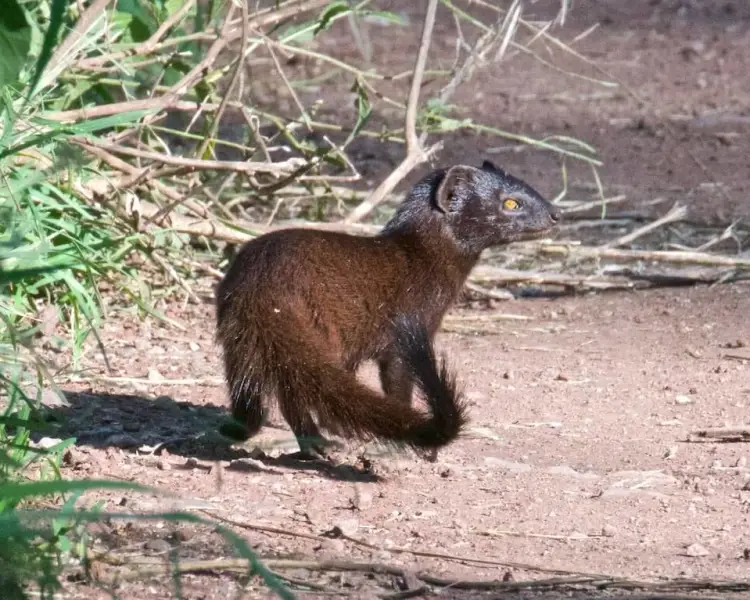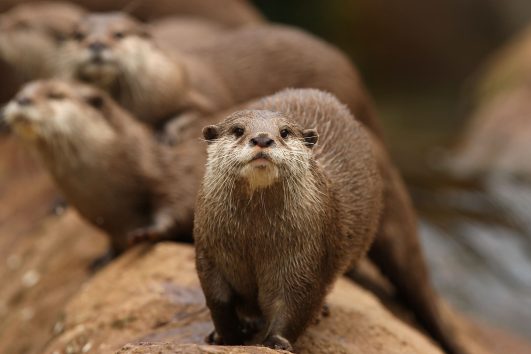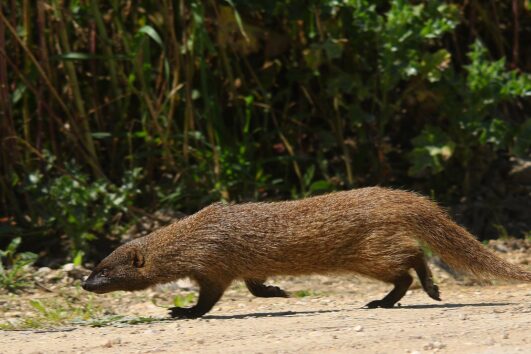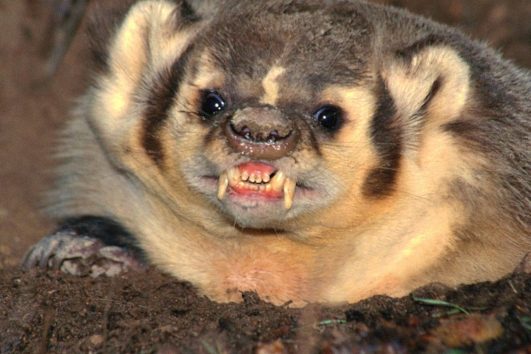The marsh mongoose (Atilax paludinosus) or water mongoose is the most aquatic species of mongoose. It has a shaggy coarse coat that is consistently dark brown. The creatures’ colors range from reddish brown to virtually black. While it has the characteristic elongated mongoose body form, its shaggy hair gives it the appearance of being less thin. The head is long and pointed, with short hair, and the ears are tiny and rounded, on the sides of the head. The feet are likewise covered with short hair, with no webbing between the toes. Long, non-retractable claws on the toes are designed for digging. Many people confuse it for an otter, despite the fact that it is considerably smaller and darker in color.
The canines are well-built, with narrow blade-like processes on the front and rear edges, however, they do wear to blunted tips. Carnassial teeth are clearly adapted to crushing rather than slicing.
Marsh Mongoose : Species Profile
COMMON NAME: Marsh Mongoose
SWAHILI NAME: Nguchiro-maji
SCIENTIFIC NAME: Atilax paludinosus
TYPE: Mammal
FOOD: Marsh mongooses are opportunistic carnivores, feeding on a variety of prey including small mammals, birds, reptiles, amphibians, insects, and crustaceans. They may also consume fruits and other plant matter.
HABITAT: Marsh mongooses inhabit wetland areas such as marshes, swamps, and riverbanks. They are native to sub-Saharan Africa.
SIZE: Marsh mongooses have a body length of approximately 40 to 55 centimeters (16 to 22 inches), with a tail length of about 20 to 30 centimeters (8 to 12 inches). They weigh between 1.5 to 2.5 kilograms (3.3 to 5.5 pounds).
AVERAGE LIFE SPAN IN THE NATURAL HABITAT: In the wild, marsh mongooses have an average lifespan of around 8 to 10 years. However, some individuals may live longer under favorable conditions.
ACTIVE: Marsh mongooses are primarily crepuscular, meaning they are most active during dawn and dusk. They are adept swimmers and climbers, allowing them to navigate through their marshland habitat with ease.
GESTATION PERIOD: The gestation period for marsh mongooses is approximately 60 to 70 days. Females give birth to litters of 2 to 4 pups, which are born in underground burrows or other sheltered areas.
WEIGHT: Marsh mongooses typically weigh between 1.5 to 2.5 kilograms (3.3 to 5.5 pounds), making them relatively small and lightweight mammals. They have a slender body, short legs, and a pointed snout.
SIZE COMPARISON TO A 6-FT MAN: Marsh mongooses are smaller than a 6-ft man, with a body length of approximately 40 to 55 centimeters (16 to 22 inches). They are well-adapted to their marshland habitat, where they can move swiftly and stealthily in search of prey.
Physical Features:
The Marsh Mongoose (Atilax paludinosus) is a medium-sized mongoose species with distinct physical characteristics.
Body: The Marsh Mongoose has a slender and elongated body, similar to other mongoose species. It measures around 40 to 50 centimeters (16 to 20 inches) in length, excluding the tail. Males are slightly larger than females.
Head: The mongoose has a relatively small head with a pointed snout, round ears, and small, dark eyes.
Fur: Its fur is dense, short, and coarse, typically colored in shades of brown or gray. The belly is usually lighter in color than the rest of the body.
Tail: One of the distinguishing features of the Marsh Mongoose is its long and bushy tail, which can reach up to half the length of its body. The tail serves as a balancing tool while climbing and maneuvering through its habitat.
Claws: The mongoose has sharp, non-retractable claws that aid in digging and climbing.
Overall, the Marsh Mongoose has a sleek and agile appearance, allowing it to navigate through the dense vegetation and wetland areas where it resides.
A. Adapted for Wetland Living:
The Marsh Mongoose boasts a slender body and a sleek coat of fur, which varies in color from dark brown to reddish-brown. Its long, tapering tail aids in balance and navigation as it moves through the watery habitats of marshes, swamps, and riverbanks. With webbed feet and sharp claws, this agile creature is well-adapted for both swimming and traversing muddy terrains.
B. Unique Facial Features:
One distinguishing feature of the Marsh Mongoose is its elongated snout, which houses a sharp set of teeth. Its keen sense of smell and excellent vision make it a skilled hunter in its watery domain.
Habitat and Range:
The Marsh Mongoose is primarily found in the wetland habitats of sub-Saharan Africa, including countries like Kenya, Uganda, Tanzania, and Botswana. It thrives in areas with abundant water sources, dense vegetation, and suitable prey populations.
Behavior and Diet:
The Marsh Mongoose (Atilax paludinosus) exhibits fascinating behaviours that contribute to its survival and adaptation in its habitat.
Nocturnal Activity: The Marsh Mongoose is primarily nocturnal, meaning it is most active during the night. It spends the daytime hours resting and sheltering in burrows or dense vegetation, emerging under the cover of darkness to forage and hunt.
Solitary Lifestyle: Marsh Mongooses are generally solitary animals, although they may occasionally be observed in pairs or small family groups. They establish and defend territories, marking them with scent markings to communicate their presence to other individuals.
Swimming Abilities: As their name suggests, Marsh Mongooses are adept swimmers. They are well adapted to their wetland habitats and can navigate through water with ease. They often swim to catch aquatic prey or to escape from predators.
Diet and Foraging: The Marsh Mongoose is an opportunistic omnivore, feeding on a variety of food sources. Its diet includes small mammals, birds, reptiles, amphibians, fish, insects, crustaceans, and plant matter such as fruits and seeds. It employs its keen sense of smell and agility to locate and capture prey.
Communication: Communication among Marsh Mongooses primarily occurs through vocalizations, scent marking, and body postures. They produce a range of vocal sounds, including grunts, chirps, and hisses, to convey messages to conspecifics and defend their territory.
Burrow Dwelling: Marsh Mongooses construct and utilize burrows for shelter and protection. These burrows are often located near water bodies or in dense vegetation, providing a safe retreat during rest periods and protection from predators.
Parental Care: Female Marsh Mongooses are responsible for rearing and raising the young. They give birth to litters of typically two to four pups, which are cared for and protected in the burrow until they are capable of venturing out on their own.
Through these behaviours, the Marsh Mongoose demonstrates its adaptability to the wetland environments it inhabits, enabling it to survive and thrive in its ecological niche.
A. Nocturnal Hunter:
The Marsh Mongoose is predominantly nocturnal, venturing out under the cover of darkness to hunt for food. It is a carnivorous mammal with a diverse diet, preying on small vertebrates such as frogs, fish, reptiles, and even small mammals. Its exceptional swimming abilities allow it to stealthily navigate the waterways in search of prey.
B. Solitary and Territorial:
Marsh Mongooses are solitary creatures, usually seen on their own or in small family groups. They mark their territories with scent markings, communicating their presence and asserting their ownership over specific areas within the wetland habitat.
Ecological Importance:
A. Predator-Prey Dynamics:
As a skilled predator, the Marsh Mongoose plays a vital role in regulating the populations of its prey species within the wetland ecosystem. By preying on small vertebrates, it helps maintain a balance and prevent any one species from dominating the wetland food web.
B. Seed Dispersal:
Although primarily carnivorous, the Marsh Mongoose also contributes to seed dispersal within wetland habitats. As it moves through the vegetation and consumes fruits and seeds, it inadvertently aids in the distribution and germination of various plant species, supporting the overall biodiversity of the wetland ecosystem.
Conservation Status and Threats:
A. Habitat Loss and Degradation:
The Marsh Mongoose faces significant threats due to habitat loss and degradation caused by human activities such as agriculture, urbanization, and drainage of wetlands. These actions disrupt the delicate balance of wetland ecosystems and reduce the available habitat for the mongoose.
B. Human-Wildlife Conflict:
In some areas, the Marsh Mongoose comes into conflict with human communities due to predation on poultry and small livestock. This can lead to retaliatory killings and further endanger the mongoose’s population.
Conservation Efforts:
A. Protected Areas and Wetland Conservation:
The establishment and management of protected areas, including wetland reserves and national parks, are crucial for safeguarding the habitats of the Marsh Mongoose. Conservation organizations work tirelessly to advocate for the protection and sustainable management of wetland ecosystems.
B. Education and Awareness:
Raising awareness among local communities about the ecological importance of wetlands and the Marsh Mongoose is vital for fostering positive attitudes towards conservation. Educational programs, community engagement initiatives, and promoting sustainable practices can help reduce human-wildlife conflicts and promote coexistence.
Atilax paludinosus
The Atilax paludinosus (Marsh Mongoose), with its unique adaptations and ecological role, is a fascinating inhabitant of the African wetlands. Protecting its habitats and addressing the threats it faces are imperative for the conservation of this remarkable species. By valuing wetland ecosystems, promoting sustainable practices, and engaging local communities, we can ensure the survival and well-being of the Marsh Mongoose and preserve the rich biodiversity of Africa’s wetlands for generations to come.
Marsh Mongoose Adaptations
The Marsh Mongoose (Atilax paludinosus) possesses various adaptations that enable it to thrive in its wetland habitat.
Semi-Aquatic Adaptations: The Marsh Mongoose has several adaptations that facilitate its semi-aquatic lifestyle.
- Webbed Feet: Marsh Mongooses have partially webbed feet, which aid in swimming and navigating through water efficiently.
- Water-Repellent Fur: Their fur is dense and water-repellent, keeping their bodies insulated and allowing them to stay dry while swimming.
Agile and Slender Body: The Marsh Mongoose has a sleek and slender body shape, which provides several advantages.
- Mobility and Flexibility: Their agile bodies allow them to move quickly and navigate through dense vegetation or water bodies with ease.
- Burrow Exploration: The slim body shape helps them enter and navigate underground burrows, which they use for shelter and protection.
Dietary Adaptations: The Marsh Mongoose has specific adaptations related to its dietary preferences and foraging behavior.
- Carnivorous Dentition: Their sharp teeth, including long canines and molars, are well-suited for tearing flesh and crushing the exoskeletons of insects.
- Versatile Diet: The Marsh Mongoose is an opportunistic feeder, with adaptations that allow it to consume a wide variety of prey items, including small mammals, birds, reptiles, amphibians, fish, insects, crustaceans, and plant matter.
Keen Senses: The Marsh Mongoose relies on its senses to navigate and survive in its environment.
- Acute Sense of Smell: Their sense of smell is highly developed, allowing them to locate prey and detect potential threats.
- Excellent Hearing and Vision: Their well-developed senses of hearing and vision help them detect movements and potential predators in their surroundings.
Territorial Behaviors: Marsh Mongooses exhibit territorial behavior, which contributes to their survival and reproductive success.
- Scent Marking: They use scent markings to communicate ownership of their territory to other individuals, reducing the likelihood of conflicts.
- Territorial Defense: Marsh Mongooses are territorial and may engage in aggressive behaviors to protect their territory from intruders.
These adaptations collectively enhance the Marsh Mongoose’s ability to thrive in its wetland habitat, ensuring its survival and successful adaptation to its ecological niche.
Where to see Marsh Mongoose in Tanzania
The Marsh Mongoose (Atilax paludinosus) can be found in various wetland habitats across Tanzania. Here are some notable locations where you have a chance to spot this fascinating creature:
Serengeti National Park:
- The vast Serengeti ecosystem is known for its diverse wildlife, including the Marsh Mongoose.
- Look for marshy areas, riverbanks, and water sources within the park, as these are ideal habitats for the species.
Ruaha National Park:
- Ruaha National Park is Tanzania’s largest national park and offers excellent opportunities to spot the Marsh Mongoose.
- Explore the park’s wetland areas, such as the Great Ruaha River, where the mongoose may be found.
Selous Game Reserve:
- Selous Game Reserve is a vast and diverse wilderness area, with wetlands and rivers providing suitable habitats for the Marsh Mongoose.
- Look for the mongoose along riverbanks and near water sources, particularly during early morning or late afternoon when they are more active.
Katavi National Park:
- Katavi National Park is a remote and lesser-known park, offering a chance to observe the Marsh Mongoose in a quieter setting.
- Explore the park’s wetlands, such as the Katuma River and seasonal lakes, where the mongoose may be encountered.
Mahale Mountains National Park:
- Located on the shores of Lake Tanganyika, Mahale Mountains National Park is known for its diverse wildlife, including the Marsh Mongoose.
- Look for the mongoose along riverbanks and near water sources, as they are attracted to the abundant food sources found in this area.
These locations provide favorable habitats for the Marsh Mongoose, but keep in mind that wildlife sightings are never guaranteed. Patience, local expertise, and guided safari experiences can significantly enhance your chances of spotting the Marsh Mongoose in Tanzania’s diverse wetland environments.
Marsh Mongoose Safari Tips
When planning a safari to spot the Marsh Mongoose (Atilax paludinosus) in Tanzania’s wetland habitats, consider the following tips:
Choose the Right Safari Destination:
- Select national parks and reserves known for their wetland habitats, such as Serengeti, Ruaha, Selous, Katavi, and Mahale Mountains.
- These areas offer suitable environments where Marsh Mongooses are commonly found.
Opt for Early Morning and Late Afternoon Game Drives:
- Marsh Mongooses are primarily active during the early morning and late afternoon hours.
- Schedule your game drives during these times to increase your chances of spotting them in action.
Look for Wetland Areas and Water Sources:
- Marsh Mongooses prefer marshy areas, riverbanks, and water sources, as these provide abundant food and shelter.
- Keep an eye out for these habitats during your safari, and scan the surroundings for signs of mongoose activity.
Be Patient and Observant:
- Wildlife sightings require patience and keen observation skills.
- Stay attentive during your safari, scanning the landscape for any movement or signs of Marsh Mongooses.
Engage the Expertise of Knowledgeable Guides:
- Experienced safari guides are invaluable resources in locating elusive wildlife, including the Marsh Mongoose.
- Seek the assistance of knowledgeable guides who can interpret signs of mongoose presence and guide you to prime viewing spots.
Following these safari tips will enhance your chances of observing Marsh Mongooses in their natural habitats. Remember to respect the wildlife and their environment by maintaining a safe distance and observing from a responsible standpoint. Enjoy the unique experience of encountering the Marsh Mongoose during your safari adventure in Tanzania!
Marsh Mongoose FAQs
Here are some frequently asked questions (FAQs) about the Marsh Mongoose (Atilax paludinosus) in Tanzania, presented with bold headings and subheadings:
1. What is the Marsh Mongoose?
- The Marsh Mongoose is a medium-sized carnivorous mammal native to sub-Saharan Africa.
- It belongs to the mongoose family and is known for its semi-aquatic nature.
2. What does the Marsh Mongoose look like?
- Appearance: The Marsh Mongoose has a slender body with short legs and a long, bushy tail.
- Size: It typically measures around 40 to 55 centimeters in length, excluding the tail.
- Coat: Its fur is coarse and varies in color from reddish-brown to gray-brown.
- Features: The Marsh Mongoose has a pointed snout, small ears, and sharp claws.
3. What is the behavior of the Marsh Mongoose?
- Social Structure: Marsh Mongooses are primarily solitary animals, but they may form small family groups.
- Nocturnal Habits: They are predominantly active during the night, hunting for food and patrolling their territory.
- Semi-Aquatic Adaptations: Marsh Mongooses are well-adapted to wetland environments, where they swim and dive for prey.
- Foraging: Their diet consists of a variety of food, including insects, small mammals, crustaceans, and amphibians.
4. Where can I see Marsh Mongooses in Tanzania?
- Habitat: Marsh Mongooses inhabit wetland areas, including marshes, swamps, riverbanks, and floodplains.
- National Parks: Look for them in wetland-rich national parks such as Selous Game Reserve, Ruaha National Park, and Katavi National Park.
5. Are Marsh Mongooses dangerous?
- Marsh Mongooses are generally not aggressive towards humans and are unlikely to pose a threat.
- However, it’s important to remember that all wildlife should be observed from a safe distance and with respect for their space.
These FAQs provide useful information about the Marsh Mongoose, its appearance, behavior, habitat, and safety considerations. Understanding these aspects will enhance your wildlife encounters and contribute to responsible viewing practices during your safari experience in Tanzania.









Tour Reviews
There are no reviews yet.
Leave a Review